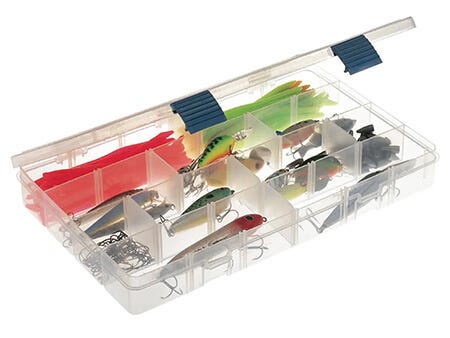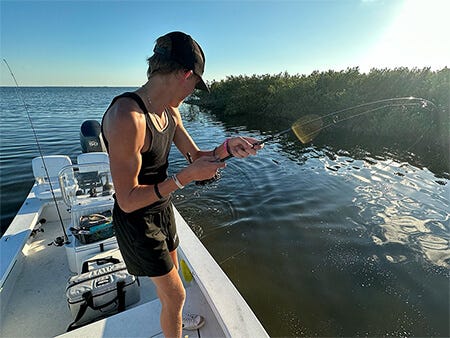

If you take your fishing seriously, you probably have the tackle to prove it. If your boat, garage, and house carry more inventory than the local tackle shop, then you probably fit in this category. And if you’re that serious about your fishing, a good portion of that tackle is probably considered “mission critical.” You may have all the right stuff, but figuring out how to have what you need when you need it requires creativity, forethought, and a good, practical, and flexible tackle storage system.
Contents
Choose a Customizable Tackle Storage System
Experienced fishermen understand patterns. They start to think in terms of seasons, species, locations and weather conditions. Each of these dynamics require specific lures, presentations and equipment. If you fish enough different patterns, the amount of tackle you need can quickly overflow a single tackle box.
You need a tackle storage system that allows you to quickly customize your tackle system to what you will need for that particular trip.
Here in coastal North Carolina, I fish a wide variety of waters and species, from chasing skinny-water redfish in the marsh all summer to dredging up striper in 40-foot-deep shipping channels during the winter months.
You need a tackle storage system that allows you to quickly customize your tackle system to what you will need for that particular trip.
Spring and fall find me working the entire water column, taking advantage of the wide variety of species that move through our waters during their seasonal migrations. Each of these situations requires different tackle, different lures and often different lines and leaders. Throw some opportunistic fly-fishing into that equation, and you can only imagine the tackle storage nightmare I faced before I finally got a system figured out.
If you find yourself struggling with tackle storage, here are a few tips to help you develop a system that will put you back in control:
Use Tackle Trays for Organization and Versatility
If monofilament and, later, braid, were game changers in modern fishing history, another game changer that gets less acclaim was the Plano-style tackle tray. This simple invention is the most critical element of any good tackle storage system.
Each tray — or combination of trays — can be organized based on your primary fishing patterns.
Redfish in the Marsh all summer? Tackle tray filled with topwater plugs, spinner baits and weedless jig heads.
Speckled trout in the fall? Tackle tray with Mirrolures, DOA shrimp and light jig heads.
Speckled trout in the fall? Tackle tray with Mirrolures, DOA shrimp and light jig heads.
Striper dredging in the winter? Tackle tray with chatter-baits, heavy jig heads and deep diving crank baits. Using soft-sided tackle boxes, bags and even coolers allow you to swap these trays out quickly as season, conditions or locations change.
Separate the Perennial from the Periodic
Some tackle is always useful, regardless of season, species or even location. Other tackle is more mission-specific. The key to an effective tackle storage system is keeping these two types of tackle separated. Mixing tackle that you only use for specific situations with tackle that you need all the time will require you to carry more tackle trays than you really need.
Mixing tackle that you only use for specific situations with tackle that you need all the time will require you to carry more tackle trays than you really need.
Your general equipment trays form the core of your tackle storage system. They get primacy of place in your tackle box, and they rarely, if ever, get removed, except for restocking. Your more mission-specific trays will be swapped in and out based on the plan for the day.
These mission-specific trays will also range from highly specific to more general, and so their location and accessibility will be dictated by the frequency of use or likelihood of need.
Think Through How You Store Your Storage
Your boat, your garage, your office and your house all become extensions of your primary tackle storage box. The tackle box forms the core and contains the most used and most useful items. As you get farther away from that box, the likelihood and frequency of need should go down.
If you primarily fish from a boat and you store tackle on it, the most accessible locations get the tackle trays you will most often need, but which don’t fit in your primary tackle box. If you rig up rods the night before a trip, the place you rig up should be as well organized as your boat and tackle box. This may require duplication of equipment, but if it keeps you from leaving a critical tray in your garage on your way to the ramp, it was well worth the redundancy.
Old bookshelves make great tackle storage tray holders, especially if those trays are clearly labeled.
Wherever you store your more mission-specific tackle trays, you want a system that keeps them organized, accessible and convenient. Old bookshelves make great tackle storage tray holders, especially if those trays are clearly labeled.
Manage the Chaos During the Heat of Battle
If the primary element of a good tackle storage system is organization before a trip, the secondary element is having a “managed chaos” system during the trip. Let’s face it, when the wind is howling, the rain is pouring or the fish are biting, your organizational prowess goes overboard.
Lures get tossed around on consoles, leader winds up on the bottom of the boat and chewed-up soft plastics go just about everywhere.
It’s chaos, and it’s fun.
There’s no use fighting it, but it can be managed if you accept that it’s going to happen whether you like it or not.
All those tossed lures, leaders, terminal tackle and soft plastics eventually need to go back to where they belong, but the time to do that is when you are back home, showered up and reminiscing over the adventure you just lived through.
Designated Dumping Areas
If you’re like me, there’s probably a crackling fire nearby and something tasty in a frosty mug, too. It’s in these calm moments that re-organization happens and the tackle storage system is returned to its proper state. But somewhere between the epic chaos during the fishing trip and that reorganization, magic can happen.
A key part of my tackle storage system is having designated dumping areas. A rushed lure swap might require the extraction of a new lure from its proper place, but the old lure goes into an easily-accessible, always-in-reach, purpose-built cup on the console. Used soft plastics and bent jig heads get tossed into the cooler with the half-eaten remains of lunch (an entirely different system). If I’m on someone else’s boat, or (gasp) not on a boat at all, there is a designated side pocket of my tackle bag for discarded and swapped-out lures.
If I’m on someone else’s boat, or (gasp) not on a boat at all, there is a designated side pocket of my tackle bag for discarded and swapped-out lures.
Rain, wind and hungry fish might keep my OCD in check, but having designated dumping grounds makes clean-up and re-organization much easier. A few minutes in the garage with the console cup, cooler, tackle bag and frosty beverage is all I need to put my world back in order and be ready for the next adventure.
Preparation Meets Simplicity
Being serious about fishing means being properly prepared. Whether we like it or not, being “prepared” means having a LOT of tackle. All that tackle does no good if it’s not where you need it, when you need it and how you need it when certain patterns present themselves.
Adopting a flexible tackle storage system based on swappable trays that are properly pre-organized ensures that you can customize your tackle box, bag or pack for the specific mission ahead. Also recognizing that, no matter how organized you go into a trip, you are likely to come out significantly less organized, can help you plan to manage the chaos and minimize the damage.
Over time, your pre-trip prep will be as simple as grabbing the right tackle trays on your way out the door.
Over time, your pre-trip prep will be as simple as grabbing the right tackle trays on your way out the door, and your post-trip routine will involve grabbing a few designated dumping areas and re-organizing your trays as you reminisce about your latest adventure.





